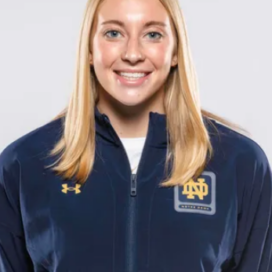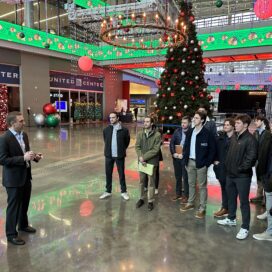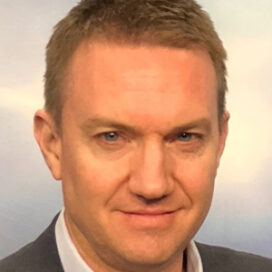Using Analytics to Identify Potential Cheaters in Weightlifting
Author: Bryan Fields
Business Analytics Senior Breaks New Ground to Identify Potential Cheaters

Mitch Feren ’23 Notre Dame ITAO Graduate
Mendoza’s Business Analytics program sometimes deals with heavy subjects. Senior Mitch Feren, who wakes up the echoes as an ND cheerleader, leveraged his passion for weightlifting for his Sports Analytics class project, PEDs in Powerlifting. He aimed to identify lifters who may have cheated by using performance enhancing drugs (PEDs) such as anabolic steroids. Part of his challenge was finding a fresh angle in a world already rife with statistics. “All major sports do heavy analytics,” said Feren, teaching assistant and Business Analytics major. “Could I find an area that hadn’t been touched yet?” Knowing that results are only as good as your data, Feren pulled up a data set of all major competitions at openpowerlifting.com. The set proved ideal because it was up-to-date and untouched by analysis such as machine learning algorithms that could have distorted the data.
Developing the Model to Identify use of PEDs

Mitch Feren Class of 2023 Irish Cheerleading
Feren hoped to identify potential cheaters in drug-tested meets and federations because he had data from federations that allow PEDs as well as ones that don’t. The presence of these two groups made it ideal to develop a model and apply machine learning algorithms to compare them. To improve his accuracy, he had to filter out certain groups. For example, to remove those least likely to cheat, he eliminated lifters over 50, minors, and competitors in meets with low-value prizes. He removed lifters who used certain types of equipment that can artificially boost how much they can lift. He also had to calculate genders differently based on weight. Because terminology can be inconsistent and data was in multiple languages, he used natural language processing tools like those used by ChatGPT to ensure he was comparing similar things. “Throughout the process I would run the model and get low-accuracy results,” he said. “But then I went back again and again to decide how to filter it. I also tried different variables to see if I got more accurate results.”
Identifying Potential Cheaters: Results and Analysis
In the end, Feren identified approximately 4,000 potential cheaters. But after subtracting “null” attempts (a lifter who listed only their top attempt instead of the normal three), the final number was about 1,600. “Once I built my final model, when I was happy with the results, I looked into individual samples that there was something significantly different about these lifters,” he said. “It felt super rewarding. I had a real sense of accomplishment. Data cleaning is not interesting but is the longest and most important part.” Feren aimed not to identify winners and disqualify them, as winners undergo testing afterward and during the off-season. Rather, it identified lifters who showed an abrupt change in their abilities that seemed unnatural.
Although the model couldn’t positively identify cheaters, it could help further develop testing protocols to make cheating harder. “I’ve done analytics in the past, but this was the most unique and most rewarding,” he said. “Also the most applicable because no one else had touched this data set so I was the first to break ground. “I wouldn’t have thought you could do something like this with a business degree,” he continued. “Instead of analyzing blood samples you’re analyzing results of competitions.” Feren said he couldn’t have done it without support from Martin Barron, assistant teaching professor in IT, Analytics, and Operations, who helped with writing code and structuring problems. “He is indispensable to these projects.”
What’s Next for Feren?
In summer of 2021, Feren began at Fidelity Investments as an investment data analyst. After graduation, he plans to return to work at Fidelity. Now, he possesses more experience that will assist him in his financial career. “The only thing I did all summer is build models at Fidelity,” he said. “So this will be the exact kind of thing I’ll be doing at work.”
See how Mendoza’s Business Analytics program can power your success.




